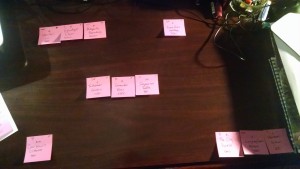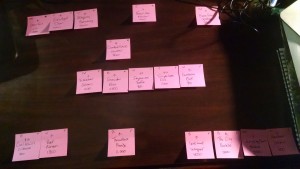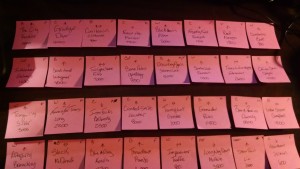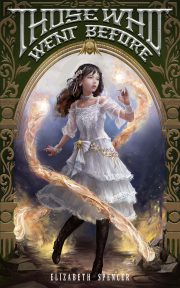Shuffling Stories, Arranging Anthologies
 by Jaym Gates
by Jaym Gates
“Put your biggest names first and last, and then load everything else in the middle.”
That was how I learned to format anthologies. It makes sense: when someone’s browsing an anthology, they’re most likely to first look at the front and the back of the book. So if you put your heavy hitters there, you’re more likely to grab a reader’s interest.
But then there’s the question of how everything else should be organized. How do I decide the order, the flow, and the balance? Do I lump it by theme, or by setting, or do I break up the themes to keep from boring the reader?
Fortunately, I have a SUPER scientific method that also satisfies my Post-it® note obsession. Yep, I write the title, author, word count, and a couple of notes on theme. I also note author gender, because it’s an interesting data point, and an arrow: ‘up’ for a story that ends cheerfully, ‘down’ for a dark story, and ß for a story that is more neutral or balances between cheerful and dark. Each story gets its own Post-it, and then I clear my desk top and start throwing Post-its everywhere.
 First, I set my cornerstones. Stories that have a lot of punch, that are powerfully evocative, that reach out and grab the reader by the throat. For Genius Loci, I chose to open with “The City”, Vivienne Pustell’s creepy, beautiful story. It’s a hell of an opening salvo.
First, I set my cornerstones. Stories that have a lot of punch, that are powerfully evocative, that reach out and grab the reader by the throat. For Genius Loci, I chose to open with “The City”, Vivienne Pustell’s creepy, beautiful story. It’s a hell of an opening salvo.
To wrap the anthology up, I knew I wanted Laura Anne Gilman’s “Heartbeat”. It’s night and day from Viv’s story in terms of setting—sunlit, dry, ancient open spaces, the sound of the wind, and a subtle threat that just slides under your skin and stays put.
Laura Anne’s story is the shortest one in the anthology, too, so it’s a fabulous little mouthful to end on, but it needed some beefy anchors. Ken Liu’s “The Snow Train” is beautiful and heartwarming, a perfect balance to Seanan McGuire’s exquisitely vicious Princess and the Frog twist. The three of them form a crescendo of a finale that, I think, will leave the reader incredibly satisfied.
 But that was only four of thirty-tw0 stories. So from there, it was just endless amounts of shuffling and second-guessing and figuring out the flow of things. Most editors are smart and have a tighter word count range, which makes for one less variable in the final construction. Me? Nope. From Gilman’s 600 word flash, to Cat Rambo’s 11,000 word novelette, I have pretty much every damn length possible. So that’s a consideration, too, because you don’t want a bunch of huge stories lumped together, or a staccato section of five super-short pieces of flash.
But that was only four of thirty-tw0 stories. So from there, it was just endless amounts of shuffling and second-guessing and figuring out the flow of things. Most editors are smart and have a tighter word count range, which makes for one less variable in the final construction. Me? Nope. From Gilman’s 600 word flash, to Cat Rambo’s 11,000 word novelette, I have pretty much every damn length possible. So that’s a consideration, too, because you don’t want a bunch of huge stories lumped together, or a staccato section of five super-short pieces of flash.
That’s another thing I have to consider when I’m putting together a table of contents: I need to consider the emotional flow of the stories, and the mental exertion. Some of the stories are dark, others are bright. Some are tear-jerkers, others warm your heart.
 So many details. So you pour a glass of wine, and you think about each story, weighing them and rehashing details over and over as a picture forms in your head, and you get everything sorted perfectly, but there’s one story that doesn’t quite fit anywhere, so you tear the whole thing apart and rebuild it from scratch.
So many details. So you pour a glass of wine, and you think about each story, weighing them and rehashing details over and over as a picture forms in your head, and you get everything sorted perfectly, but there’s one story that doesn’t quite fit anywhere, so you tear the whole thing apart and rebuild it from scratch.
And you do this until pieces start falling into place, and suddenly you have this piece of macro-art, like a quilt or a really great dish. At least, that’s my hope. We’ll see how I succeeded when the book goes out to backers in a couple of months. (Photo 4)
•••
Gates is an editor, author, and communications director. Her previous work includes War Stories, Broken Time Blues, and Geek Love. Her current project is Genius Loci, which was a successful Kickstarter project: https://www.kickstarter.com/projects/1089607742/genius-loci-tales-of-the-spirit-of-place


